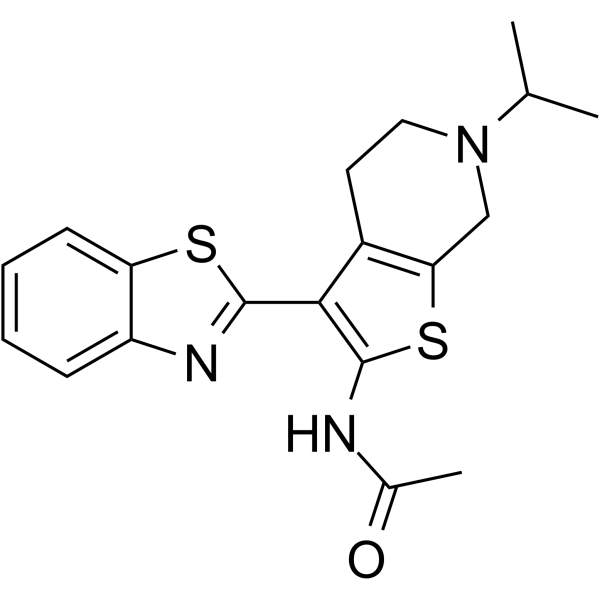524708-03-0
| Name | N-(3-(benzo[d]thiazol-2-yl)-6-isopropyl-4,5,6,7-tetrahydrothieno[2,3-c]pyridin-2-yl)acetamide |
|---|---|
| Synonyms |
N-(3-Benzo[d]thiazol-2-yl-6-isopropyl-4,5,6,7-tetrahydrothieno[2,3-c]pyridin-2-yl)acetamide
APE1 Inhibitor III |
| Description | APE1-IN-1 is a potent and blood-brain barrier (BBB) penetrant apurinic/apyrimidinic (AP) endonuclease 1 (APE1) inhibitor with an IC50 value of 2 μM. APE1-IN-1 can potentiate the cytotoxicity of the alkylating agents Methylmethane sulfonate and Temozolomide (HY-17364) to cancer cells[1]. |
|---|---|
| Related Catalog | |
| Target |
IC50: 2 μM (APE1)[1] |
| In Vitro | APE1-IN-1 (compound 3) exhibits an IC50 of 2 μM in the qHTS assay and an IC50 of 12 μM in a radiotracer incision assay (RIA)[1]. APE1-IN-1 (0, 1, 3, 10, 30, or 100 μM; 15 min) inhibits HeLa whole cell extract AP site incision in a dose-dependent manner[1]. APE1-IN-1 (5-30 μM; 24 h) exhibits cytotoxic activity against HeLa cells, and potentiates the activity of methyl methansulfonate and Temozolomide (HY-17364)[1]. Cell Cytotoxicity Assay[1] Cell Line: HeLa cells Concentration: 5-30 μM Incubation Time: 24 h Result: Exhibited cytotoxic activity against HeLa cells with a 50% reduction in cell viability occurring at ~15 μM. Greatly potentiated the activity of methyl methansulfonate (0.4 mM) and Temozolomide (HY-17364) (1 mM) with optimal synergy occurring at ~5 μM and ~10 μM, respectively. |
| In Vivo | APE1-IN-1 (30 mpk; IP; single dosage) exhibits favorable pharmacokinetic property[1]. Pharmacokinetic Parameters of APE1-IN-1 (compound 3) (IP; 30 mpk) in CD1 mice[1]. Plasma Brain t1/2 (h) 2.1 1 brain/plasma 21 Cmax (μM) 16 217 tmax (h) 0.25 0.25 CLogP 2.83 Animal Model: CD1 male mice (n = 3)[1] Dosage: 30 mpk Administration: IP; single dosage Result: Showed lipophilic (CLogP = 2.8), crossed the BBB quite readily, giving rise to a B/P ratio of 21. |
| References |
| Molecular Formula | C19H21N3OS2 |
|---|---|
| Molecular Weight | 371.52000 |
| Exact Mass | 371.11300 |
| PSA | 101.71000 |
| LogP | 4.76060 |
